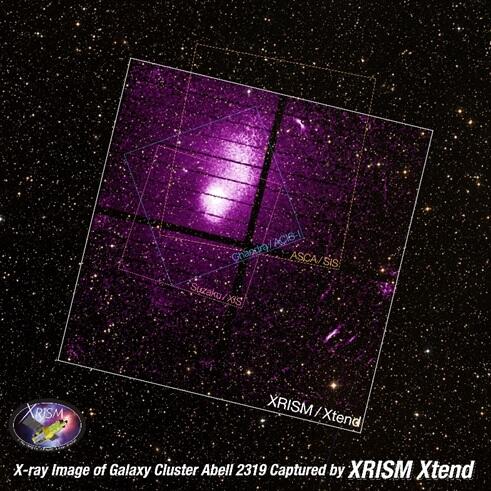The Japan Aerospace Exploration Agency (JAXA) has released first light observation data from the soft X-ray imager Xtend and the soft X-ray spectrometer Resolve onboard the X-ray spectroscopic imaging satellite XRISM (X-ray Imaging and Spectroscopy Mission), launched last September. Xtend successfully captured X-ray images of the galaxy cluster Abell 2319, situated approximately 770 million light-years away, during observations conducted from October 14-24, 2023.

Credit: X-ray (JAXA), Optical (DSS*) *The Digitized Sky Survey
In the past, owing to the limited field of view, X-ray observations covered only the central part of galaxy clusters, or multiple observations were conducted to cover the outer parts. In this study, Xtend's X-ray CCD captured an area equivalent to a full moon in size through a single observation that encompassed the entire galaxy cluster.
The galaxy clusters observed in this research are undergoing a collision, and the Xtend images depict the distribution of hot gas associated with each cluster. To understand the full extent of collisions between galaxy clusters, as well as the evolution of the large-scale structure of the universe, extensive observations of galaxy clusters, including their outer regions, are needed. This first light image of two colliding galaxy clusters is expected to significantly advance such research.
Resolve also captured N132D, a supernova remnant (trace of a stellar explosion) in the Large Magellanic Cloud, on December 4-11, 2023, and successfully obtained a detailed X-ray spectrum.
X-ray spectra from Resolve show emission lines from various ions over a bandwidth of 1800-10,000 eV. Compared to the spectra obtained by the X-ray astronomy satellite Suzaku, those obtained by Resolve show multiple resolved emission lines that were indistinguishable from those of Suzaku. This resolution of emission lines makes it possible to identify the elements in the observed hot gas and determine their quantities, as well as the temperature and velocity of the hot gas, with much greater precision than before.
Resolve features ultra-high-resolution spectroscopy in the high-energy band. The energy spectral accuracy was confirmed in orbit to be less than 5 eV, which is below the required 7 eV. The spectra of Resolve are still limited to energies over 1800 eV as the aperture door protecting the sensitive detector has not been yet opened. The spectrometer has achieved the world's highest emission line sensitivity in this bandwidth.
These emission lines are produced from the interior of the star that originated this supernova and the supernova explosion. The observations with Resolve are expected to yield new insights into the generation and circulation of elements that form the basis of stars, planets, and even life within the cosmic context.
The satellite is currently in good condition, and initial functional verification operations continue with the aim of transitioning to regular operations. A functional verification of the bus equipment (power supply system, attitude control system, communication system, etc.) has been completed, and all equipment was confirmed to be working as designed. Xtend cooled the X-ray CCD to the specified temperature of -110℃ and it was confirmed that images could be acquired in all observation modes. Resolve cooled the X-ray microcalorimeter to the cryogenic temperature of -273.1℃ (0.05 K), successfully and stably controlling it to achieve a spectral resolution higher than the required value.
Although the detector's protective aperture door is not currently being opened according to the prescribed procedure, the opening procedure will be performed again after the environmental conditions are appropriately changed.
As groundbreaking observation results can be expected even with the protective aperture door closed, the regular operation phase will begin this year with full-scale observations for initial calibration verification in parallel with operations with the door open.
This article has been translated by JST with permission from The Science News Ltd. (https://sci-news.co.jp/). Unauthorized reproduction of the article and photographs is prohibited.




